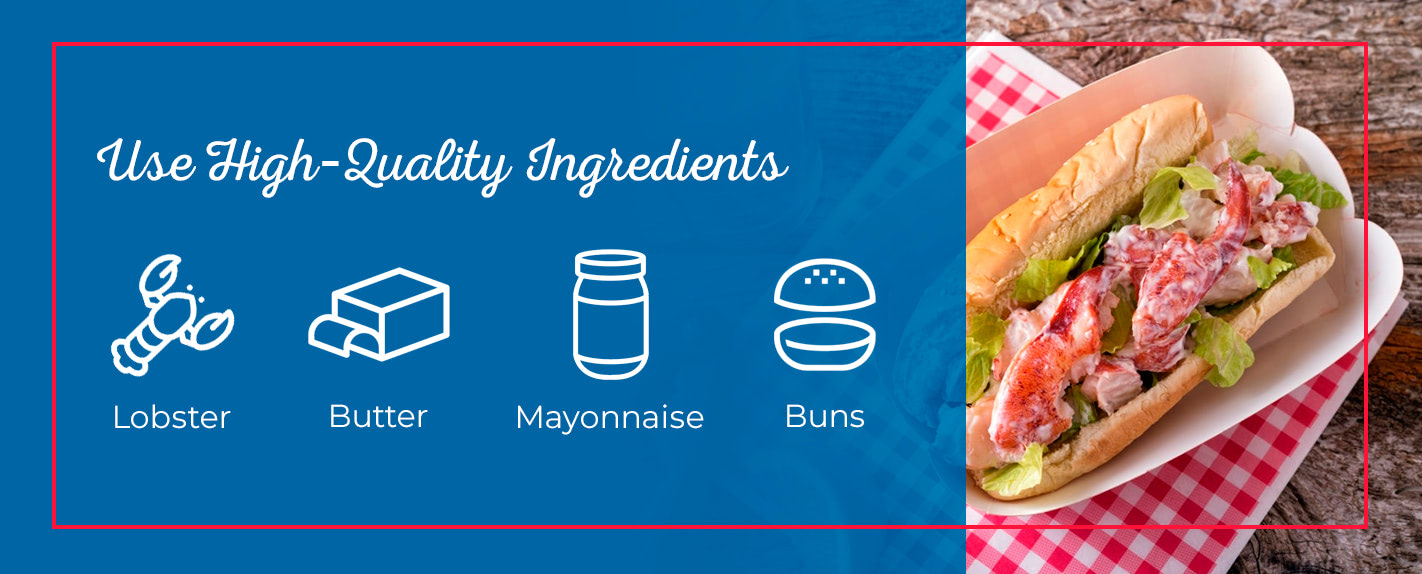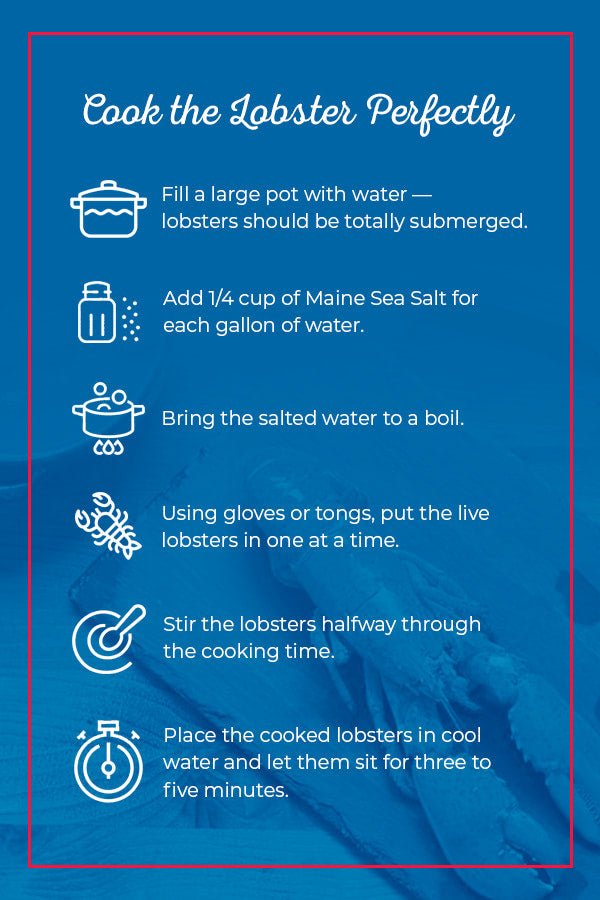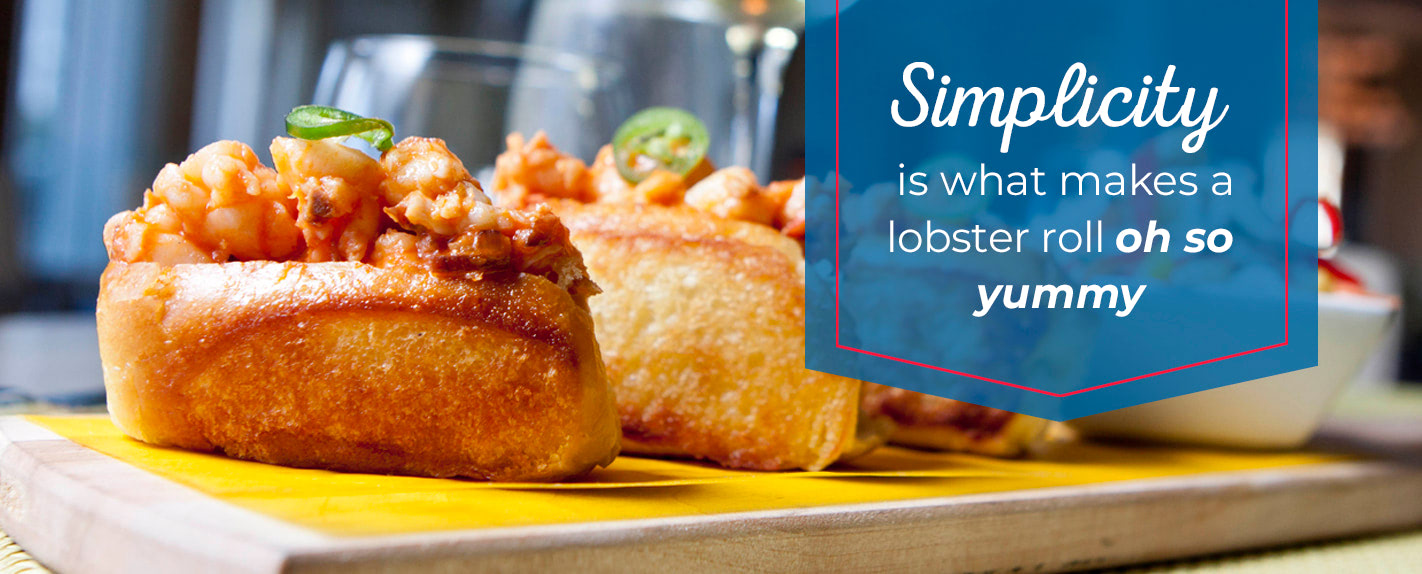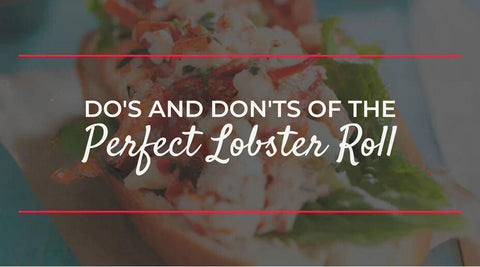A lobster roll is the quintessential New England summer food. Nothing beats biting into a toasted top-sliced hot dog bun packed with delectable chunks of sweet, tender lobster meat.
So, how do New Englanders get it right? The best lobster rolls keep it simple and focus on the lobster. In this post, we'll share do's and don'ts so you can see what we mean. As you'll soon discover, you can prepare a traditional mouthwatering lobster roll no matter where you live.
The Do's Of A Good Lobster Roll
Did you invite your best pals over for a lobster roll picnic? Keep the following do's in mind so you can whip up crowd-pleasing lobster roll like a New Englander.

1. Use High-Quality Ingredients
A classic lobster roll is all about quality over quantity. You only need a few ingredients to construct a glorious lobster roll, but remember that each one counts — a lot. Here are the fundamental lobster roll ingredients, and what you need to consider before you start your shopping list.
- Lobster: Your priority as a soon-to-be lobster roll master is to find the freshest, most tender lobster meat you can get. Without high-quality lobster meat, you won't be able to have an authentic lobster roll experience. The best lobsters you'll find in this country come from Maine. Maine lobsters thrive in cold water and offer gigantic claws packed with sweet, delicate meat. On the other hand, warm-water lobsters found in the Pacific don't have claws, and they generally have meat that is less tender and flavorful. Therefore, choose quality live lobster from Maine, and you'll be on your way to lobster roll paradise.
- Butter: Butter is an integral part of a lobster roll. You need quality butter to toast the buns. If you prefer a lobster roll with no mayo, you can also use butter as the perfect substitute for that. All butters are not created equal. They vary in flavor, texture, and moisture levels. Choose a quality butter like Kate's Butter, which highlights the sweetness of lobster meat without overpowering the taste. Always avoid using whipped butter or light butter with your lobster rolls.
- Mayonnaise: For many New Englanders, the best lobster roll dressing is mayo. Choose a brand like Hellmann's, which people love for its richness and homemade-like quality. Avoid heavily flavored dressings which could overpower the lobster roll.
- Buns: The second most important element of a traditional lobster roll is the bun. It's essential to use soft white-bread rolls and avoid hard bread. You want to be able to savor the lobster meat texture and lose it in chewing bread that is too tough. We also highly recommend using split-top hot dog buns. A split-top bun features flat sides — perfect for absorbing the butter and forming a toasted golden crust.
2. Toast the Bun
Toasting the bun is a critical step in the lobster-roll-making process. A toasted bun is slightly sweet, which helps bring out the sweetness of the lobster meat, and adds a satisfying crunchy, but not overdone, contrast to the tender lobster. With split-top rolls, you can easily toast both sides to perfection.
You'll want to toast the buns before assembling the lobster rolls. You can spread butter or mayo on each bun and toast both sides in a toaster oven, under the broiler, on the grill or in a skillet. Just make sure not to over-toast the buns. The goal is to form a golden, lightly toasted layer.
3. Cook the Lobster Perfectly
The lobster meat is always the main event when it comes to lobster rolls. To fully enjoy plump, tender chunks of lobster, you must properly cook the lobster. Otherwise, your lobster may not live up to its flavor potential.

If you're concerned about your lobster-cooking abilities, have no fear. Even if you've never seen a live lobster up close before, you can still learn to cook lobster perfectly and make outstanding lobster rolls. The first step is to choose live lobsters from Maine. Fresh, live lobsters will produce the best meat for your lobster rolls.
Next, you'll need to choose a cooking method. Although there are several ways to cook a lobster, we highly recommend boiling your lobster. Boiling is the easiest way to cook a live lobster for beginners, and it allows you to infuse the lobster with saltwater flavor. Boiling the lobster for the right amount of time also won't dry out the meat. Here are our instructions for perfectly boiled lobsters:
- Fill a large pot with water — lobsters should be totally submerged.
- Add 1/4 cup of Maine Sea Salt for each gallon of water.
- Bring the salted water to a boil.
- Using gloves or tongs, put the live lobsters in one at a time.
- Stir the lobsters halfway through the cooking time.
- The lobsters are done when they're bright red.
- Place the cooked lobsters in cool water and let them sit for three to five minutes.
Cooking times vary depending on the size of the lobster. For example, a one-pound lobster takes eight minutes to cook, while a two-pound lobster takes 15. Also, make sure to use the largest pot you have, because you do not want any crowding.
You can test the lobster and make sure it's cooked through with a simple trick. Wait 10 minutes after you remove the lobster from the water, and then set it on its back. Bend and release the tail. If the tail springs back on the counter, the lobster is done. If the tail moves slowly, the lobster needs a little more cooking time. It's better to check your lobster and have to cook it longer than to overcook it the first time.
After you cook the lobster, you need to remove the meat carefully. You want to keep the meat intact as much as possible so you can pack your rolls with bite-sized pieces. You can use tools like a lobster cracker and seafood picks to crack open shells and extract the meat. For example, to remove the claw meat, first, twist off the claws. Next, use a lobster cracker to crack open each claw and knuckle. Use a seafood pick to push or pull the meat out.
4. Add a Twist
If you want to journey beyond traditional lobster rolls, you can have fun and get creative with ingredients and still have a delicious lobster roll — as long as you don't take away from the lobster flavor. There are plenty of ways to add a unique twist to this summertime staple without overpowering the delicate lobster. Here are some add-ons and mix-ins to consider.
- Vegetables: Vegetables can add a refreshing crunch and nutrition boost to any lobster dish, and lobster rolls are no exception. You can experiment with different vegetables by either adding chopped veggies to the lobster-mayo mixture or topping each lobster roll with vegetables. For example, you might add a little bit of chopped celery or red onion to the mix. Or, you could top a lobster roll with butter lettuce, pea shoots, pickled carrots or cucumber slices.
- Seasonings: You can safely choose from a variety of herbs and spices to lightly season your lobster rolls. For example, you might add a pinch or two of freshly ground black pepper, oregano, chives, tarragon, dill, cilantro or celery salt. You can add the seasonings to the lobster-mayo mix or as a garnish. It's a good idea to add herbs or spices to a small amount of mayo first to test the flavor, then mix it with the lobster meat. You can also add different herbs or spices to melted butter before drizzling it over the lobster roll. Lastly, you can amplify the flavor by adding a squeeze of lime or lemon juice on top.
- Other seafood: No law says a lobster roll must consist entirely of lobster meat. If you also love other types of seafood like shrimp or crab, have fun adding them to the lobster mix for a seafood feast roll.
- Sides: If you're wondering what to serve with lobster rolls, you have many enticing options. You can go the traditional route and serve the rolls with fries or Fox Family Potato chips. Add a pickle spear to cut through the richness of the lobster roll and refresh your palate between bites. To try something a bit more unconventional, consider serving lobster rolls with veggie fries or a shaved fennel salad.
For more inspiration, try the Avocado Lobster Roll With Lime Mayo recipe. With this recipe, you'll use lime, bacon and avocado to add a yummy twist to classic flavors.
The Don'ts of a Perfect Lobster Roll
Are you getting excited about homemade lobster rolls? You're halfway to becoming a lobster roll pro. You just need to consider what not to do when you make lobster rolls, and you'll be good to go.
1. Overdo the Mayo

Although mayonnaise is the tried-and-true lobster roll dressing, you shouldn't douse the lobster meat with mayo because you don't want to mask the sweet flavor of the meat. Use only enough mayo to hold the pieces of meat together, starting with a little at a time and increasing as needed.
Serious Eats recommends tossing warm lobster with a few teaspoons of mayo per pound of lobster meat. Then, place the mayo-coated meat in a colander over a bowl and set it in the refrigerator. Excess mayo will drip from the meat, leaving flavorful, lightly coated chunks behind.
Instead of adding too much mayo, you can also toss lobster meat with a little bit of melted butter before mixing it with a simple mayonnaise-based dressing. If you choose not to use mayo at all and use butter as a dressing instead, follow the same rule — don't overpower the meat with the butter.
Lastly, you don't necessarily have to mix butter or mayo with the meat. Some chefs prefer to spread a thin layer of butter or mayo on the bun and then stack the lobster chunks on top.
2. Serve at Room Temperature
We recommend not serving lobster rolls at room temperature for safety reasons. Instead, aim to serve your lobster rolls either hot or cold to keep them safe from bacteria growth. According to the Department of Agriculture, keep cold food at 40 degrees Fahrenheit or colder, and hot food at 140 degrees Fahrenheit or warmer.
Whether you choose to serve lobster rolls hot or cold depends on whether you prefer butter or mayo. A traditional Maine-style lobster roll is mayonnaise-dressed and served cold. As New Englanders know, a cold, creamy lobster roll can hit the spot on a summer day. Another popular way to serve a New England style lobster roll is hot with melted butter. Why not enjoy hot buttery lobster rolls in the winter, and cold mayo rolls in the summer?
3. Overpower the Lobster
You don't want to overpower the sweet, delicate flavor of the lobster. This rule is essential to keep in mind, especially as you encounter the aisles of different dressings and seasonings in the grocery store. You'll especially want to avoid adding strong, bitter foods to lobster rolls such as arugula or kale. Also, avoid intense flavors that could potentially overwhelm the lobster, such as tomatoes, blue cheese or wasabi. Stay focused on the lobster, and everything should turn out fine.
4. Make It Too Complicated

Part of the beauty of a lobster roll is its delicious simplicity. That means fewer ingredients you have to buy and prepare, and more room to savor the flavors. There's also no need to stress out about trying new recipes. People love lobster rolls for their simple, quality ingredients. When it comes to lobster rolls, it's usually best to stick to tradition. All you need to impress a crowd and your taste buds is quality lobster meat, a buttered, toasted roll and a bit of mayo. You might add a squeeze of lemon and a dash of fresh chopped herbs if you like, but you won't need much more than that.
So, to make the perfect lobster roll, take a breath, relax and remember – simplicity is what makes a lobster roll oh so yummy.
Do Make It Even Easier With Maine Lobster Now
Lobster rolls are a summertime staple, and you can enjoy them whether you live in Maine or hundreds of miles away. Best of all, making delicious lobster rolls does not need to be a complicated process. We make it even easier to bring high-quality Maine-style lobster rolls to the table.
At Maine Lobster Now, we offer easy DIY Lobster Roll Kits, available six-pack rolls to please the family or a group of friends. Our kits include all the ingredients you need to build perfect lobster rolls quickly and easily, from fresh, pre-cooked Maine lobster meat to soft split-top buns. We even include kettle chips so you and your guests can enjoy the full experience. Taste the reason New Englanders are proud of their lobster rolls, and order a lobster roll kit today!





